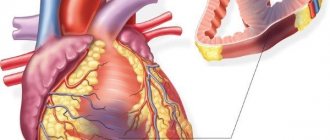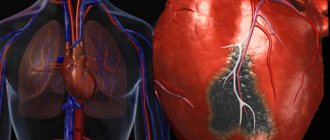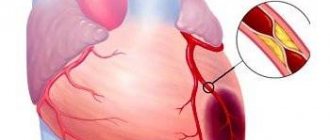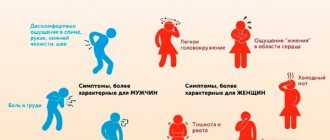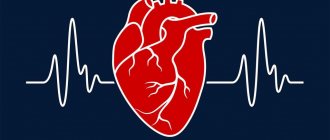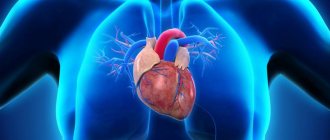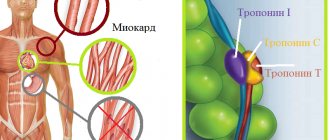The heart is the most important vital organ of a person. Any problems that relate to the field of cardiology are considered the most threatening to human life. A person lives and works as long as the heart correctly and uninterruptedly copes with blood circulation throughout the body. Failures in the functioning of the heart entail problems of the most severe category, and its failure means death.
The most dangerous pathology in cardiology is considered to be “myocardial infarction,” which is characterized by serious disturbances in the functioning of the heart, leading to irreversible consequences, the worst of which is death. Statistics show that mortality from heart attack occupies a leading position; sometimes even prompt assistance does not guarantee the absence of further complications. In this article we will tell you what kind of complications there are after myocardial infarction, what their classification is, periods of occurrence and features of the course.
A little about the disease
Myocardial infarction often evolves as a result of cardiac ischemia, characterized by long-term pathologies of blood circulation in the muscles of a vital organ that precede the disease. The root cause of the progression of the disease is often the blockage of one or more coronary vessels by a blood clot, as a result of which the muscular tissues of the organ stop receiving the substances necessary for normal functioning, which causes death or necrosis of the epithelium of the heart. Due to the destruction of heart tissue, muscles lose their ability to contract, and a person’s blood circulation decreases.
The patient’s chances of recovery depend on the volume of the tissue segment that has undergone the pathological process. The most serious is considered to be an extensive myocardial infarction, abbreviated as AMI, covering the entire volume of the heart. Often, with AMI, a person dies in the first hour after the incident; it is possible to save him in extremely rare cases, even with immediate assistance from doctors. In the case of local focal necrosis, the patient has a chance of recovery if he promptly goes to a medical center and in the absence of aggravating factors.
In case of myocardial infarction, the patient is subject to mandatory hospitalization with urgent placement in intensive care, where the first therapeutic measures are taken to stabilize the patient’s condition.
Thromboendocarditis
Another complication of myocardial infarction is thromboendocarditis. The pathological condition is the appearance of blood clots in the cardiac cavities located parietally, on the heart valves and endocardium in combination with endocarditis (inflammation of the endocardium)
The clinical picture includes:
- Low-grade fever (body temperature rises to 38),
- Antibiotic resistance
- Asthenic syndrome (weakness, lethargy, apathy),
- Increased sweating
- Increased heart rate,
- Thromboembolism (blockage of a vessel with a blood clot) in the systemic circulation,
- Increase in ESR.
The basic method for diagnosing thrombus endocarditis is echocardioscopy (ultrasound of the heart).
Classification of complications after a heart attack
Statistical data proves in numbers that most people with this disease die in the first hour after the incident if immediate assistance is not provided or it is impossible to stop the pathological process even with the help of medical resuscitation measures. However, even those people who survived a heart attack should not rejoice and relax, since rehabilitation is long and burdensome, and complications are very unpredictable.
The condition of a patient who has survived a myocardial infarction can become more complicated at any time after the illness. Acute and subacute time intervals after the precedent are considered the most unstable. The acute phase is characterized by a large percentage of deterioration in the patient’s health condition and lasts approximately ten days after the start of abnormal processes in the heart. The next most unreliable period is the subacute period, lasting up to a month. During this period, relapses of the disease with irreversible consequences are also possible.
After a month has passed after the onset of the disease, a period begins that medicine qualifies as post-infarction. Its duration reaches one year. During this period, the patient may become a victim of late exacerbations, which are no less life-threatening than early manifestations of the pathology.
The official classification of complications of myocardial infarction divides the consequences into two categories - early and late deterioration of the patient’s health.
Early complications of myocardial infarction:
- cardiac shock;
- swelling of the lungs;
- acute heart failure;
- deviations in heart rate and vascular patency, ventricular atrial fibrillation;
- thrombus formation, which leads to impaired blood circulation;
- ruptures of the septa of the heart muscles, resulting in the formation of tamponade;
- pericarditis.
Late complications of myocardial infarction:
- thromboembolism, namely obstruction of blood vessels in the heart and other organs;
- post-infarction syndrome;
- cardiac aneurysm;
- heart failure, which has degenerated into a chronic course of the disease.
In addition to classification into time intervals, there is a distribution of complications according to their types in medicine. Cardiology identifies the following categories of consequences of a heart attack:
- Violations of the integrity of segments of the heart muscles and blood vessels, which are classified as mechanical damage.
- Electrical pathologies, which are expressed by heart rhythm disturbances, arrhythmia of varying degrees.
- Anomalies of the embolic class, developing due to the formation of blood clots.
- Progression of necrosis, which is classified as ischemic pathologies.
- Inflammatory processes of varying severity in the heart region.
Let us consider in detail the most common complications of myocardial infarction, which manifest themselves during different periods of the patient’s rehabilitation, their specificity and possible consequences.
A little history
The history of myocardial infarction dates back to the 19th century. At autopsies of deceased patients, isolated cases of this pathology were described. A detailed description of myocardial infarction in 1909 was first given by Soviet scientists, then working at Kiev University, professor, Russian therapist Vasily Parmenovich Obraztsov and member of the USSR Academy of Medical Sciences, therapist Nikolai Dmitrievich Strazhesko.
They described how the disease myocardial infarction develops and described in detail its symptoms and diagnosis, and also noted the various clinical forms of this pathology. They clarified that special attention should be paid to thrombosis of the coronary arteries, which is the most common cause of heart attack. This brought them worldwide fame. Thus, the history of myocardial infarction began with their jointly published work.
These two great Soviet scientists began to work together and study diseases of the cardiac system after N. D. Strazhesko married Natalya Vasilyevna Obraztsova (daughter of V. P. Obraztsov) in 1901. In 1909, these scientists made the world's first lifetime diagnosis of coronary thrombosis.
Features of early complications of myocardial infarction
The most common complication of myocardial infarction in the first hours or days after its onset is acute heart failure, which often provokes the death of the patient. It manifests itself in the form of cardiac asthma, which makes itself felt to the patient with asphyxia, severe shortness of breath and an inexplicable feeling of fear. Helps eliminate the symptoms of cardiac asthma most often by taking Nitroglycerin tablets. However, the next step should be to urgently seek medical help, since asthma is most often followed by more serious complications that can be fatal for the patient and require serious therapy.
Pulmonary edema is considered a more widespread post-infarction pathology. It manifests itself as symptoms of loud breathing, often with bubbling in the throat, as well as incessant coughing attacks with pinkish sputum. Such a complication requires emergency medical intervention; it is impossible to eliminate such an abnormal process on your own at home. If the patient is not provided with immediate assistance, cardiac shock will further progress. The initial symptoms of cardiogenic shock are unexplained increased activity of the patient with clear indicators of shortness of breath and pain in the chest region. Additionally, the patient may complain of dizziness and body aches. Further, the person’s condition becomes more complicated, a decrease in blood pressure is added to the previous symptoms, the patient becomes apathetic and powerless, and before our eyes turns into a lifeless body.
External signs of cardiac shock:
- protruding cold sweat;
- change in body color to bluish;
- decreased response to external stimuli.
- a person’s limbs begin to get cold and lose sensitivity.
If the patient is not provided with urgent care in a hospital setting, the patient will fall into a coma and then die.
Experts in the field of cardiology call the consequence in the form of pathology of the heart rhythm a “companion” of a heart attack. The most dangerous violations of this plan are observed in the first five hours after the onset of the disease, mainly in men; the female body is less prone to such abnormal processes. It is treated directly in intensive care conditions with the help of medications and defibrillation of the ventricles of the heart. The chances of eliminating the arrhythmia and restoring the patient vary depending on the severity of the abnormal processes. Arrhythmia can also develop in later post-infarction periods, however, in the future, most often it does not pose a threat to the patient’s life with appropriate treatment.
Early complications of a heart attack also include heart rupture or partial mechanical deformation. The complication is accompanied by pain in the chest region; often even narcotic painkillers cannot eliminate it. This pathology can be observed in the first few days after the development of the disease and often leads to the instant death of the patient. If ruptures have formed in the internal parts of the heart, without compromising the external integrity of the organ, most often the patient can be saved through surgical intervention.
Thromboembolism is a dangerous post-infarction pathology in the body that can occur at any stage of the patient’s rehabilitation. Blood clots that form in the chambers of the heart during a heart attack do not always have time to dissolve under the influence of antithrombotic drugs, and over time enter the vessels and spread throughout the body. Accordingly, after some time, blockage of a vessel can occur in any part of the patient’s body, which causes serious pathologies and consequences, the treatment of which depends on the location of the problem.
Pericarditis is an inflammation of the inner lining of the heart. Occurs in most people who have had a heart attack. The first signs of complications begin mainly a few days after the incident and are characterized by dull pain in the sternum and a slight increase in body temperature. With timely initiation of treatment, which consists of taking anti-inflammatory drugs, pericarditis does not pose a threat to the patient’s life.
Early signs of a heart attack
There are signs that can help identify the development of a heart attack even before it occurs. These early signs include precursors of the disease, which appear in patients several weeks before the attack:
- increased fatigue, lack of energy, which is not relieved even by long rest;
- shallow or interrupted sleep, insomnia;
- snoring during sleep, apnea;
- swelling of the legs, feet and hands caused by poor blood flow and weak heart function. Numbness or tingling of the extremities;
- gastrointestinal disorders for no apparent reason in women. This symptom is explained by the fact that the diaphragm of the stomach and the digestive organs in the female body are close to the heart muscle. Thus, with ischemia of the lower parts of the posterior wall of the heart ventricle, this part of the body suffers;
- attacks of unexplained anxiety;
- frequent headaches, episodes of visual impairment;
- bleeding gums caused by impaired blood supply to peripheral vessels;
- difficulty trying to take a deep breath or shortness of breath with little physical exertion;
- rapid heartbeat, arrhythmia - consequences of damage to the coronary artery;
- increased urge to urinate at night;
- discomfort in the chest, in the heart area.
These signs are nonspecific, that is, they are not characteristic of a heart attack, but the simultaneous presence of several of them is a reason for a cardiac examination.
Characteristics of late complications after a heart attack
The most common late complication after a heart attack is heart failure, which progresses and develops over time into a chronic form. The reasons for its evolution may be unfavorable circumstances, non-compliance with doctors' advice on rehabilitation. Most often, this phenomenon is observed in men who smoke or abuse alcohol, as well as in patients who overwork themselves with physical activity after discharge from the hospital.
The complication is signaled by frequent shortness of breath, heaviness of breathing, and regular swelling of the limbs. From a medical point of view, such a deterioration in the patient’s health belongs to a complex category, since it arises due to the insufficient strength of the heart to pump blood through the human body in a sufficient volume, thereby not supplying oxygen and useful substances necessary for normal functioning to vital organs. In such a situation, patients are prescribed medications from the category of beta blockers, which reduce the need of the heart muscle for oxygen, as well as drugs that help restore blood circulation in the body. Giving up bad habits and maintaining a healthy lifestyle helps reduce the occurrence of complications.
Post-infarction syndrome is often characterized by an autoimmune continuation of a heart attack, which is expressed by inflammatory processes in the body at different locations. This can be inflammation of the pleura, lungs, pericardium, joints and blood vessels. This reaction of the body is explained by its weakening after illness and the inability to fight various autoimmune diseases. The risk group for this complication includes people who have autoimmune problems in their pathogenesis. As in the previous case, most often such a complication is observed in men leading an inferior lifestyle.
Thromboembolism in the late period after a heart attack most often occurs due to the patient’s poor nutrition and irregular intake of prophylactic medications. A tendency to such a complication occurs in people suffering from diabetes mellitus and elevated blood cholesterol levels. The risk group also includes people who, before a heart attack, had serious problems with the vascular system of the body.
Cardiac aneurysm, as a consequence of the disease, progresses most often two months after a heart attack, when scarring of the damaged cardiac epithelium ends. Often, the resulting scar prevents the full functionality of the organ, thereby causing the progression of heart failure. The presence of such a defect in the organ is determined using special medical computer examinations, and treatment often involves surgical intervention.
Late consequences of a heart attack
At the end of the acute period of the disease, so-called late consequences may develop. These include complications that appear 10 days after the manifestation of MI and later:
- post-infarction Dressler syndrome occurs 2-6 weeks after the manifestation of myocardial infarction and is manifested by inflammation of the pericardium, pleura, alveoli, joints and other pathological changes;
- thromboendocarditis with thromboembolic syndrome (the appearance of a wall thrombus in the heart cavity, on the heart valves);
- late post-infarction angina, which is characterized by the occurrence or increase in frequency of angina attacks. Its frequency ranges from 20 to 60%.
Some patients who have suffered an acute myocardial infarction are at high risk for developing repeated complications of coronary heart disease and, above all, recurrent myocardial infarction and unstable angina. This is due to the fact that in patients with acute coronary syndrome, along with the presence of an atherosclerotic plaque, which was complicated by a rupture and blocked the lumen of the coronary artery, there are plaques in other arteries. They can be the cause of repeated episodes of cardiovascular events, the probability of which is very high.
Prospects for recovery
A heart attack is considered a very serious cardiac disease, the prospects for recovery after which are not always comforting for the patient and his relatives. With a large heart attack, the patient’s chances of recovery are negligible, even with prompt assistance to the patient. If the heart attack is of a small localization, with concomitant favorable indicators, the patient can get back on his feet and continue to live a normal life for several more decades.
The patient’s chances of recovery are influenced by indicators of the person’s overall health status and his age, and the timeliness of providing qualified assistance. Proper and effective rehabilitation, which includes following doctors’ orders, taking preventive medications and ensuring a correct lifestyle, increases the prospects for a patient’s recovery after a heart attack.
The risk of developing a second heart attack, which is more life-threatening than the primary one, is high in men who are prone to obesity, the use of harmful drugs, narcotic substances, and alcohol. Incorrect nutrition also causes aggravation of the disease, development of concomitant pathologies, as well as relapse of the disease.
Post-infarction autoimmune Dressler syndrome
This disease is represented by a combination of several pathological conditions:
- Pericarditis,
- Pleurisy,
- Pneumonitis
- Lesions of the articular synovial membranes of the joints.
This is an autoimmune pathology in which autoantibodies to myocardial and pericardial antigens appear in the blood. The development of the syndrome most often occurs in the second week after an acute infarction, but can sometimes act as an early complication during the first week.
The incidence of this complication is 15-20%. In comparison with epistenocardial pericarditis, the inflammatory process in the case of Dressler's syndrome is widespread and not focal.
Clinical picture:
- Fever,
- Pain in the heart area,
- Chest pain
- Increased intensity of pain during breathing,
- Pleural friction noise,
- Pericardial friction rub
- Wheezing as a symptom of pneumonitis,
- Joint pain
- Increase in the number of leukocytes,
- Acceleration of ESR.
Recommendations for rehabilitation after a heart attack
A patient who has suffered a heart attack, while still in the hospital, needs to prepare himself mentally for long-term rehabilitation and restoration of basic body functions.
The patient’s recovery should include the following stages:
- Inpatient treatment until the patient’s health is completely stabilized.
- Rehabilitation in special centers that specialize in the recovery of post-infarction patients.
- Home therapy under the strict supervision of cardiologists.
The period after a heart attack requires the patient to be very careful about his health. Proper nutrition is one of the areas of a healthy lifestyle that helps restore the patient’s strength after illness. The patient's diet should be as balanced as possible in terms of the amount of proteins, fats and carbohydrates; meals should consist only of healthy ingredients.
Giving up bad habits is the second mandatory rule for a person who has had a heart attack. Alcohol and nicotine, even in small quantities, can provoke an exacerbation of the disease with a fatal outcome, and also reduce the effectiveness of preventive drug therapy.
Physical activity is an integral part of stabilizing blood circulation and tone of blood vessels. Upon discharge, doctors recommend individual physical exercises, which are allowed for the patient and will accompany recovery. In addition, it is useful to take walks in the fresh air, which not only promote the restoration of the musculoskeletal system, but also improve the state of the body's respiratory functions and stimulate blood circulation.
Restoring the nervous system includes providing comfortable conditions for the patient, eliminating various stressful situations and experiences. Moral support from family and friends helps to cope with post-infarction depression.
In the post-infarction period, it is important to undergo regular examinations in medical institutions, take all necessary tests in a timely manner and undergo additional prescribed procedures.
Prevention of complications
To protect yourself from complications of a heart attack, the patient should definitely adhere to the following recommendations:
- In the first days after the attack, observe strict bed rest.
- Take all medications prescribed by your doctor. Treatment should be under the supervision of a specialist.
- Be sure to follow a dietary diet (diet No. 10). At the same time, it is worth completely giving up fatty foods and alcohol, and limiting the consumption of sweet, spicy, sour and starchy foods.
- During the recovery period, regularly perform special exercises and physical therapy.
- Give up bad habits (smoking).
- Avoid stress and nervous tension. Also, a person should change his work and rest schedule, sleep at least 8 hours a day.
- Limit heavy physical activity, especially heavy lifting, running, and push-ups.
- Maintain body weight. It is very dangerous to gain weight after a heart attack.
- Control blood pressure and cholesterol levels.
- Regularly see a doctor (cardiologist, therapist).
Complications after myocardial infarction sometimes cause more harm to the body than the initial attack. It is much more difficult for a person to recover from them, since he will definitely need a second course of drug therapy.
That is why it is important to initially treat after a heart attack and follow clinical recommendations to prevent further deterioration of the condition.
Let's sum it up
The post-infarction period is difficult not only for the patient’s relatives and friends, but also for the patient himself. During this period, it is too early to rejoice at the fact that you managed to survive after a complex illness; you must try to do everything to avoid relapses and complications after the illness. Rehabilitation after an illness is characterized by the versatility of therapeutic measures and has many pitfalls in the form of unforeseen complications.
Complications of varying severity can manifest themselves throughout the year after the illness and are classified by varying degrees of severity and risk to life. It is up to the person himself and those around him to reduce risk factors for life; sometimes it is enough to maintain a healthy lifestyle, and for relatives to simply provide moral support to the patient.
Acute period
Complications that occurred during the acute period include acute heart failure and cardiogenic shock. These consequences are the earliest and most severe.
In general, heart failure is a common occurrence after a heart attack and its severity depends on the “area” of myocardial damage. The severe stage of acute heart failure results in cardiogenic shock, characterized by a decrease in the pumping function of the myocardium as a result of tissue necrosis. As a rule, such complications occur in older women and patients with diabetes.
Treatment of complications that manifest themselves in the acute period consists of taking nitroglycerin, ACE inhibitors, diuretics and vasopressors. Endovascular methods include coronary angioplasty and intra-aortic balloon counterpulsation. In extreme cases, doctors perform surgery.
After a myocardial infarction, other complications . Such as:
- Rupture of the interventricular septum. A septal rupture can occur within the first 5 days after a heart attack. As a rule, it is observed in older people, women, as well as with hypertension, and anterior heart attacks. Typically, specialists provide earlier surgical treatment for this complication. It is also possible to use endovascular methods. Among drug treatments, vasodilators are relevant.
- Mitral insufficiency. A huge number of myocardial infarctions are complicated by mild or moderate mitral regurgitation. Usually the deficiency is transient. A severe form of mitral regurgitation is caused by rupture of the papillary muscle. This form is the most dangerous. As a rule, mitral insufficiency occurs with infarctions of lower localization. Treatment for this complication should be medication, and in severe cases caused by ischemia, coronary angioplasty is recommended. A rupture of the papillary muscle must be operated on immediately, otherwise a poor prognosis is guaranteed.
- Rupture of the free wall of the left ventricle. This complication occurs exclusively with the transmural type of infarction. During the first five days, 50% of ruptures occur. Patients who have experienced a heart attack for the first time, as well as women, older people and those who suffer from arterial hypertension are at risk. In this case, urgent surgical intervention is required.
- Thromboembolism. This disease usually develops within ten days after 24 hours. Typically, thromboebolism of the systemic circulation occurs with infarctions of anterior localization. Treatment involves slow intravenous heparin, followed by anticoagulant therapy with warfarin.
- Early pericarditis. This disease is characterized as an inflammatory process that develops in 10% of patients who have survived myocardial infarction. This happens within the first four days. Typically, pericarditis develops when all three layers of the heart are affected. For this disease, it is recommended to take aspirin up to 6 times a day.
- Arrhythmia is the most common consequence of early heart attack. Occurs in approximately 90% of patients. This consequence of a heart attack requires urgent medical attention, since left ventricular fibrillation provokes a cessation of contractile activity of the heart, followed by cardiac arrest. Immediate electrical defibrillation of the heart muscle is required.
- Pulmonary edema often occurs in the first seven days after a heart attack. The cause is acute heart failure. Pulmonary edema requires urgent medical attention. Doctors should administer intravenous diuretics and glycosides.
- Acute left ventricular aneurysm usually develops during transmural infarction. Acute aneurysm is dangerous due to severe heart failure, and a state of shock is possible. In this case, specialists prescribe intravenous vasodilators. If the patient's condition does not improve, doctors recommend surgery.
